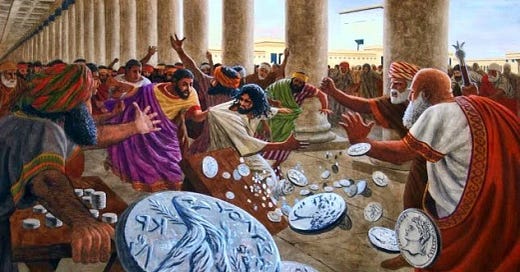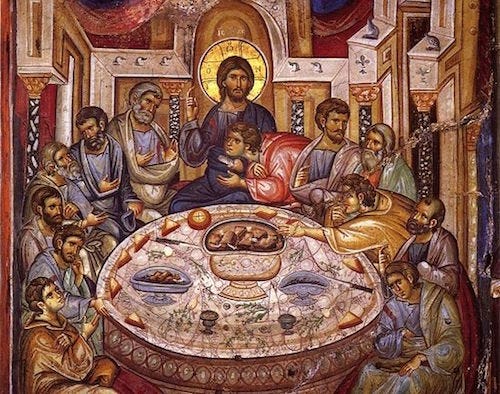I believe part of the narrative of Passion Week tells us the story of two tables. The table that Jesus turns over in the temple is the transaction table (John 2:13-17). The table where the Lord’s Supper is instituted amid Passover is the table of transfiguration (Matthew 26:26-29).
.
One night as I slept, I was awakened by the phrase: “Transactional vs. Transfigurational Conversations.” I began to picture a table, and the Holy Spirit started to say some things to me. The “table” that I saw was Cross-shaped, indicating that it was a place of communion and sacrament. It is Eucharist, where Augustine says, “You are to be taken and broken and distributed, that the work of the Incarnation may go forward.”
The table was a place for eating a meal and communion (Lk. 22:21) and for the business transactions carried out by money changers (Jn. 2:15).
The table is also the place of the Lord’s Supper, where we can lay our heads on Jesus’s breast to hear His heartbeat. But, at the time, it was the space where Satan entered those more interested in transactions for natural revolution.
The table becomes the place where we are invited to commune with the Triune God and learn to abide. (Jn. 14:23) The table can also be the place where Jesus turns over the table of transactions and sets up the table of remembrance where He “re-members” His Body parts back into alignment with His heart and headship.
And He had given thanks, broke it, and said, “This is my body, which is for you. Do this in remembrance of me.”
“Transactional” is a business and marketing term derived from the word “transaction,” which is buying and selling goods and services. Transactional describes a business deal and an exchange or interaction between people.
Transactional conversions with Jesus are when we are at the table to receive what the Lord is offering, yet unwilling to be exposed or transparent before Him. It’s a place where we desire to see the unveiling of Jesus but are reluctant to reveal our motives.
When we are more driven to receive from the Lord for the purposes of building projects (sermons, prophetic words, books, expanding, and building) than we are to come into union with His death, we are in a transactional business exchange for the building project formed by the works of the flesh. It’s building a ministry and a life based on the blueprint of a Jesus formed in our own image. Instead of us being an icon, an image that gives witness to Christ for His glory, we become an idol that draws glory to ourselves instead.
Transactional conversations are self-serving and self-building and produce the workmanship of our own hands. It’s where we have lost the art of active listening, which involves being quick to listen and slow to speak (Jas. 1:19).
Transfigurational Conversations
Transfigurational conversations are not driven by self but by a self-emptying heart posture. The conversations are a way of life, a continual road to Emmaus where Jesus interrupts and disrupts our conversation to invite us into the mystery of His wounds to be healed and delivered.
It is a road to Damascus where the glory of the Cross blinds us to see Him after the flesh no longer but awakens us to see Him after the Spirit. As we see Him, we become like Him as we abide at the table.
Transfigurational conversations are walking with Christ in the intimacy of discipleship as Enoch walked with God and became a “was not” because we are entering into union with Christ. It is where the table becomes “apocalyptic” in the sense that we come to the end of ourselves, and the world as we know it comes to an end as we step into new beginnings. It is the tasting of the One who is both the Beginning and the End.
Genesis 5:24 Enoch walked with God and was not found, for God took him.
Our conversation becomes eucharistic as we eat of His flesh and drink of His blood. It’s through abiding at the table that we are conformed, transfigured, and shaped in the cruciform image of the King to “re-present” His ways and actions.
In his letter to the Corinthians, Paul uses the same Greek word, metaphoroo, used to describe Jesus unveiling His glory on the mountain.
And we all, with unveiled face, beholding the glory of the Lord, are being transformed (transfigured) into the same image from one degree of glory to another. For this comes from the Lord, who is the Spirit.[1]
According to Luke’s account, Moses and Elijah spoke with Jesus about His death, which is the word exodus in Greek. It was by the blood of the Lamb that Israel was delivered out of Egypt, and it is by the blood of the Lamb of God that we conceive of His image and are delivered (birthed) out of Egypt.
The Mount of Transfiguration happens at the Lord’s Table. It is also an altar and a table where the Word of God on the Cross enters our conversation at the altar to “alter” our conversation (ways, thoughts, behaviors), just as a caterpillar transforms into a butterfly.
It’s the living Word of God revealed that untwists our distorted ways of living and thinking and interweaves them with His will. As we eat of His flesh and drink of His blood at the table, our disfigurement becomes transfigured by the willingness of the Lamb to be marred and disfigured for us.
As many were astonished at you, his appearance was so marred (Hebrew mishchath; disfigurement, corruption) beyond human semblance, and his form beyond that of the children of mankind . . .[2]
He was beaten and disfigured to deliver His image bearers from the corruption and disfigurement that results from sin. At the table, as the cost of His blood becomes known, we enter that same experience through communion. Hence, the sprinkling of His blood pierces our hearts and transfigures our corruption into incorruption from one degree of glory to the next. We are being transfigured from the inside out.
Transfigurational conversations remind me of a powerful truth that Henry Nouwen shares regarding Jesus seeing Nathaniel under the tree in John 1:47–51:
This wonderful story about seeing through to the heart of things raises a deeper question:
Do I want to be fully seen by Jesus?
Do I want to be known by him? If I do, then a faith can grow that will open my eyes to heaven and reveal Jesus as the Son of God. I will see great things when I am willing to be seen. I will receive new eyes that can see the mysteries of God’s life, but only when I allow God to see me, all of me, even those parts I do not want to see. [3]
Transfigurational conversations mean “gazing,” whereas transactional ones only catch a “glimpse.” Gazing is looking deeper with wonder and amazement until we are “pierced” with His piercings as we “pierce” through the veil of darkness to be enlightened by the glorious light of His wounds.
To glimpse is when we see partially while attempting to make an entire story out of a glimpse. Unless we allow His illumination to pierce us and expose our hearts, we will only catch a glimpse; without a piercing, there remains a transaction.
Transfigurational conversations mean abiding at the table, whereas transactional conversations are about visiting the table to make a transaction. The table is transfigurational, transparent, and transcendent.
Jesus continues to lead us by the hermeneutic of His Sufferings. It is a journey of rediscovery and reimagining what it means to walk with Christ, be in Christ, and know that Christ is in us.
He has led us to the Cross, which has become a cross-shaped table. That same has become an altar that has altered me. At this table, communion has opened the matrix of my soul to taste and see the beauty in communion with the sufferings of Christ in the community and the communion of the saints.
We are still on the Road to Emmaus.
It is learning to commune and communicate with the blood that still speaks and gives alterations to fleshly garments as we are clothed with the Bridal garments of Lamb skin as a Bride that makes herself ready to be spotless, without a wrinkle or blemish.
Every time I think, I see clearly, He vanishes, and I must chase Him into the cloud of unknowing because my heart burns with a piercing passion when He speaks to me, in me, and through me. So may this Passion Week, we all learn to burn deeper with His Passion and come into deeper fellowship with His Sufferings by the power of His Resurrection.
[1] 2 Cor. 3:18
[2] Is. 52:14
[3] Henry Nouwen, Discernment: Reading the Signs of Daily Life (New York: HarperOne, 2015).






